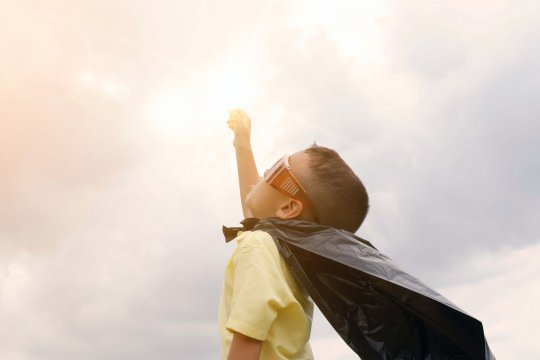Why is it worth talking about courage? And does being careful pay off?

Bold – cautious
Each of us is brave in some situations and cautious in others. What if we can’t choose between courage and caution or the border between courage and bravado is blurred? These decisions are even more difficult for a child. Therefore, it’s worth analysing examples of situations with them, so they can see how you can react and what the consequences may be. There are two versions of the exercise. The first one consists in reading sample situations out and talking about them. The other one can be done as part of motor play activities. To perform the latter, you’ll need quite a lot of space and props. Uncoil 2-3 metres of rope on the floor or stick paper tape to it. Place two cards: “BRAVE” and “CAUTIOUS” at opposite ends of the line.
Explain the rules to the child: in a moment we will stand next to the rope. There are two different words at its ends: “BRAVE” and “CAUTIOUS”. I’ll give examples of different situations. Let’s consider whether they would require caution or courage. Once you’ve made your decision, stand next to the rope to show whether in a given situation, you’d be leaning more to caution, bravery or you’d be somewhere in the middle.
Examples of situations:
* I have to go shopping in an unknown place;
* I cross the street;
* I’m supposed to tell my sister/brother, mum/dad or friend that I’m angry with them;
* I want to tell my whole family or class about an event;
* I’m supposed to perform in front of my parents in a play;
* I want to join others who are playing;
* I have a dentist appointment;
* I’m supposed to go to an unknown place;
* I meet someone new.
What do you consider brave?
Talk to your child about what brave behaviour they have seen in other people (on TV, on the bus, in the street). You can consider various aspects of courage. What emotions and feelings come to your mind when you think about courage? What do we think when we are trying to muster courage, when we are brave or have already shown courage? Do we need other people to be brave? Does being brave mean putting yourself at risk? Suggest that your child should make a comic book entitled “That was really brave!” – you’ll find an appropriate template here.
What helps us be brave?
Together, think about what can help you act brave in important situations. Write down or draw what you need to behave this way. Discuss your ideas. You can hang the drawings in a visible place at home so that you can look at them when you feel that you need reinforcement. It’s also an opportunity to talk about the consequences of our behaviour and about courage turning into bravado or excessive caution preventing us from trying new things.
All source materials are prepared by the team of Kulczyk Foundation’s Education Department in cooperation with teachers and experts – pedagogists, psychologists and cultural experts – and verified by an experienced family therapist Kamila Becker. Kinga Kuszak, PhD, Professor of Adam Mickiewicz University, Faculty of Educational Studies, provides content-related supervision over Kulczyk Foundation’s educational materials. All materials are covered by the content patronage of the Faculty of Educational Studies of Adam Mickiewicz University.
The article was published on 29.04.2020 on the website of Instytut Dobrego Życia (Good Life Institute)
Authors: Marta Tomaszewska (Kulczyk Foundation) and Anna Woźniak (Instytut Dobrego Życia)

